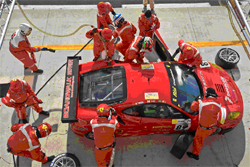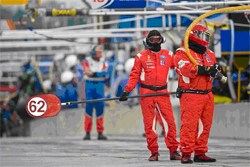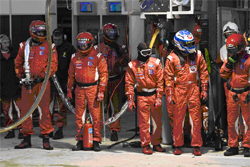The Dynamics of an ALMS Event - The Pit stop

Seemingly chaotic, the work of a pit crew is like a carefully choreographed ballet.
The enjoyment of an American Le Mans Series race can be greatly enhanced by understanding the strategies employed and what happens during pit stops. The work performed is not always obvious. Seemingly chaotic, the machinations of a pit stop are none the less specially choreographed. Put simply, their value cannot be overstated. Races can be won or lost in the pits.
In a typical 165 minute race the maximum driving time for any driver is two hours, necessitating at least one driver change. Given approximately five laps notice by the engineer via radio, the driver begins to prepare to pit about halfway through the last lap. The driver disconnects the drinks tube, helmet cooler and drinks bottle, making ready to take them on exiting the car. In the pit lane the driver loosens the belts slightly, but does not undo them. To do so would be against the regulations and result in a penalty. The radio is disconnected last so the engineer can be advised of any last minute comments or instructions about the car.

A "lollipop" or stop board informs the driver where to stop.
Outside the car there is more activity and--depending on how tight the competition is at the head of the field--much more pressure. While a total of 12 people constitute a pit team, only four of them can touch the car at any one time, just two while fueling.
One pit team member is assigned to wave a stop board or sign known as a ‘lollipop’ to let the driver know where the pit is located, especially helpful if the pit lane is full. In addition to the requisite full fireproof overalls that everyone must wear, the two refuelers must also wear full fireproof underwear, full-face helmets and visors with fresh air coolers and skirts for added protection. One refueler waits for the car to stop and the driver to turn off the engine. The refueler is holding a hose that comes from a regulated fuel tower in the pits. The hose weighs up to 30 pounds, which explains why fuelers are usually the largest guys on the team. A vent man holds another hose or receptacle onto a pressure vent which releases air from the fueling system as the gas goes in. Watching over all of this is a fireman, a team member equipped with an extinguisher in case of a flash fire or emergency.

The two fuelers are usually the largest members of a pit crew.
As soon as refueling is finished and the hose disconnected, a tire-changer hoists the vehicle, using pneumatic air jacks built into the car. Four team members change the tires, using high-speed air-powered guns that release and tighten a single, central wheel nut. A good tire stop takes less than 10 seconds. They do this 26 or more times in a 24-hour race.

Author, Fiona Miller, confers with Risi Competizione driver, Jaime Melo.
The true skill of a team’s strategist or engineering team can be seen when there are caution periods. The timing of a stop is critical not only in terms of fuel economy but also in gaining a track advantage over rivals. The balance of a race can be swung one way or the other at such times.
The penalties for getting things wrong in a pit stop affect not only race position, but also safety. Fortunately, there have been few incidents of fire or injury, but they do happen and teams are always prepared. A slick pit stop is orchestrated like a carefully choreographed ballet. And, to some, just as rewarding to watch. With an increased understanding of these orchestrations, perhaps you’ll add the pits to your “must see” vantage points at your next ALMS event.








